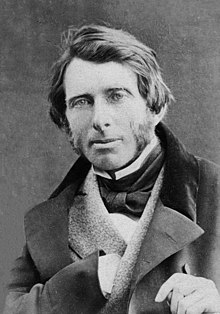John Ruskin
John Ruskin was the leading English art critic of the Victorian era, he was also an artist himself, a prominent social thinker and philanthropist. A man of many talents. He wrote about subjects as varied as geology, architecture, myth, ornithology, literature, education, botany and political economy. His writing styles were as equally varied. But, in all of his writings he emphasised the connections between nature, art and society. He was largely influential in the later 19th century after the first world war. After a period of decline his reputation started to improve. Today, his ideas are recognised as having a high influence and anticipation on the environmentalism, sustainability and craft.
From the 1850's he championed the Pre-Raphaelites who were influenced by his ideas. He first came into contact with Millais after the artists approached him through their mutual friend Coventry Patmore. Initially, Ruskin was uninterested and unimpressed with Millais's work, the piece was considered blasphemous at the time. But Ruskin wrote letters defending the piece later in 1851. Spurring Millais on in the summer of 1853 the artist and his brother travelled to Scotland with Ruskin where he painted the landscapes and later perhaps as a thank you Ruskin's portrait was added to the piece. After Ruskins divorce on the grounds of "non-consummation", his wife soon married Millais. Ruskin still continued to support Hunt and Rossetti, and financially supported Elizabeth Siddal, Rossetti's wife and he also supported other members of the Pre-Raphaelites financially. His work soon became more and more focused on social and political issues.
From the late 1840's to 1842, Ruskin was abroad with his parents, mainly in Italy. He studied Italian art guided by George Richmond (english painter and portraitist 1809-1896). Before Ruskin began Modern Painters, John had begun collecting watercolours including work from Samuel Prout and in 1839, Turner.

No comments:
Post a Comment